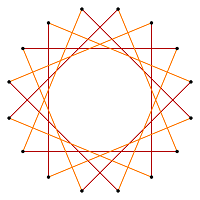The Stars of 2017

What is the average of the angles at all the points of all of the stars inscribed in a 2017-sided polygon?
Give your answer, in degrees, to 3 decimal places.
Details and Assumptions:
-
All the stars and the polygon itself are regular, that is, each star is constructed by connecting every vertex of the polygon until all the vertices are used. 2017 is a prime number , so every star will be a single self-intersecting polygon.
-
The regular 2017-sided polygon is not considered a star.
-
The angles to be averaged are the internal angles at the vertices of the stars.
Image credit: Wikiepdia Tomruen .
The answer is 89.866.
This section requires Javascript.
You are seeing this because something didn't load right. We suggest you, (a) try
refreshing the page, (b) enabling javascript if it is disabled on your browser and,
finally, (c)
loading the
non-javascript version of this page
. We're sorry about the hassle.
Let's call {2017, 2} the star obtained by skipping just a single vertex (that is going to the second vertex from the current one). The next one, {2017, 3}, will be obtained by going to every third vertex, etc. The last possible start will have lines going to the last vertex before reaching half way around and will be called {2017, 1008}. The sum of the internal angles of a star designated {p, q} is
p × 1 8 0 − q × 3 6 0
This can be shown by using triangles made by two vertices following each other within the star and the center of the star. The star can be decomposed into p such triangles, each contributing 1 8 0 ∘ . The sum of the internal angles of the star is then obtained by subtracting the angle made by the triangles at the center. This angle is 3 6 0 ∘ times the number of times the line making up the star, and consequently the line of triangles, wraps itself around the center. This number is q .
We can list the angles totals for the stars in order, starting with {2017, 2}:
( 2 0 1 7 − 4 ) × 1 8 0 , ( 2 0 1 7 − 6 ) × 1 8 0 , ( 2 0 1 7 − 8 ) × 1 8 0 , ( 2 0 1 7 − 1 0 ) × 1 8 0 , . . . 3 × 1 8 0 , 1 × 1 8 0
Basically what we need to do is add all the odd numbers starting with 1 and ending with 2013, then multiply the answer by 180. The sum of all odd numbers from 1 to n is
( 2 n + 1 ) 2
So our total of the angles will be ( 2 2 0 1 3 + 1 ) 2 × 1 8 0 = 1 0 0 7 2 × 1 8 0 .
This total will need to be divided by p = 2 0 1 7 , since there are 2017 angles per star, and by the total number of stars, which is 1 0 0 7 .